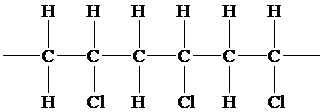
Concept explainers
Interpretation:
The Lewis structure of vinyl chloride, repeating units of vinyl chloride, and the enthalpy change are to be calculated.
Concept Introduction:
The standard enthalpy for a reaction is the amount of enthalpy change that occurs to occur understandard conditions(room temperature and pressure)
The enthalpy of reaction can be calculated as:
Here, BE represents the average value of bond enthalpy.
Answer to Problem 128AP
Solution:
(a)

(b)

(c)
Explanation of Solution
a)The Lewis structure of vinyl chloride
There are a total of 18 electrons in
The skeletal structure for

The Lewis structure for

b)Draw a portion of the molecule showing three
The poly vinyl chloride has the repeating chain of
The portion of poly vinyl chloride for three repeating chain of

Given information:
Mass,
c) The enthalpy change when
The molar mass of vinyl chloride is
The moles of vinyl chloride can be calculated as:
Substitute
The enthalpy of reaction can be calculated as:
From table 8.6, the enthalpy of formation values are:
Now, the standard enthalpy of a given reaction is:
Substitute,
The heat released is
Substitute
Hence, the enthalpy change is
Want to see more full solutions like this?
Chapter 8 Solutions
Chemistry
- Calculate the pH and the pOH of each of the following solutions at 25 °C for which the substances ionize completely: (a) 0.000259 M HClO4arrow_forwardWhat is the pH of a 1.0 L buffer made with 0.300 mol of HF (Ka = 6.8 × 10⁻⁴) and 0.200 mol of NaF to which 0.160 mol of NaOH were added?arrow_forwardDetermine if the following salt is neutral, acidic or basic. If acidic or basic, write the appropriate equilibrium equation for the acid or base that exists when the salt is dissolved in aqueous solution. If neutral, simply write only NR. Be sure to include the proper phases for all species within the reaction. NaN₃arrow_forward
- A. Draw the structure of each of the following alcohols. Then draw and name the product you would expect to produce by the oxidation of each. a. 4-Methyl-2-heptanol b. 3,4-Dimethyl-1-pentanol c. 4-Ethyl-2-heptanol d. 5,7-Dichloro-3-heptanolarrow_forwardWhat is the pH of a 1.0 L buffer made with 0.300 mol of HF (Ka = 6.8 × 10⁻⁴) and 0.200 mol of NaF to which 0.160 mol of NaOH were added?arrow_forwardCan I please get help with this.arrow_forward
- Determine if the following salt is neutral, acidic or basic. If acidic or basic, write the appropriate equilibrium equation for the acid or base that exists when the salt is dissolved in aqueous solution. If neutral, simply write only NR. Be sure to include the proper phases for all species within the reaction. N₂H₅ClO₄arrow_forwardPlease help me with identifying these.arrow_forwardCan I please get help with this?arrow_forward
 Chemistry: Principles and PracticeChemistryISBN:9780534420123Author:Daniel L. Reger, Scott R. Goode, David W. Ball, Edward MercerPublisher:Cengage Learning
Chemistry: Principles and PracticeChemistryISBN:9780534420123Author:Daniel L. Reger, Scott R. Goode, David W. Ball, Edward MercerPublisher:Cengage Learning
